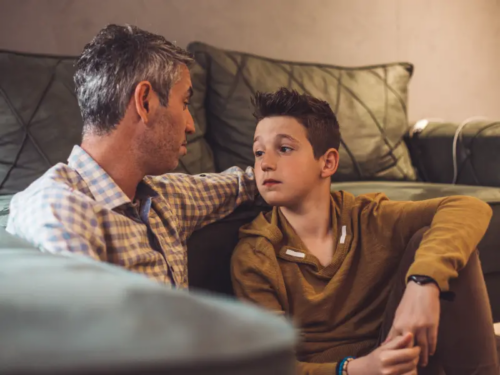
Table of Contents
Reactive Attachment Disorder Can Take a Toll on Teen Mental Health

Written By: Sarah Fielding

Clinically Reviewed By: Dr. Don Gasparini
March 21, 2024
5 min.
Reactive attachment disorder first manifests in children under five, usually due to childhood trauma, but can have a profound impact on teens.
Learn more about our Clinical Review Process
Table of Contents
The environment a person grows up in, and the adults around them, tremendously impact their mental health. Being raised in a caring environment, for instance, can provide people with a secure attachment style. Having a primary caregiver in early childhood who is abusive or neglectful, though, can lead to an insecure attachment style and, in some instances, reactive attachment disorder — a mental health disorder stemming from childhood trauma.
While reactive attachment disorder typically develops during childhood, it can impact a person into their teenage years and beyond. Below, we dig into what you need to know about how the disorder manifests in teens and how to seek treatment.

We help teens heal from childhood trauma
Evidence-based therapy with people who get it.
What is reactive attachment disorder?
According to the Diagnostic and Statistical Manual of Mental Disorders 5th Edition (DSM-5), reactive attachment disorder is “a trauma- and stressor-related condition of early childhood caused by social neglect or maltreatment.” The condition can actually take two forms: inhibited and disinhibited. “The inhibited subtype often internalizes problems while the disinhibited subtype overly engages with unfamiliar adults and does not seem to separate them from the caregiver,” says Charlie Health Primary Therapist Asha Clark, LPC.
Medical professionals typically diagnose the condition in children between nine months old and five years of age using criteria outlined in the DSM-5. A person must have a history of “extremely insufficient care” (like basic needs deprivation), constantly changing primary caregivers (like in foster care), or an unusual setting during their upbringing. Initial symptoms should present before the age of five, and the person being diagnosed should have a developmental age of at least nine months. A young person living with reactive attachment disorder also can’t meet the criteria for autism spectrum disorder, as they are “mutually exclusive” conditions.
The exact number of people living with reactive disorder isn’t clear, with estimates varying based on sample population and study. According to Clark, about 10% of children who have a history of neglect or severe abuse will receive a reactive attachment disorder diagnosis. It’s thought that a more significant percentage of children who have lived in foster care receive a reactive attachment disorder.

Experiencing reactive attachment disorder as a teen
Reactive attachment disorder develops when a person is a young child, but it can have a tremendous impact on teenagers. As Clark explains, reactive attachment disorder often causes teens to feel lonely and experience recurring sadness. They also might emotionally detach from others or isolate themselves.
In fact, there are many signs of reactive attachment disorder in teens that can indicate the condition’s presence and a need for treatment. According to Clark, reactive attachment disorder symptoms in teenagers include:
- Rare or minimal comfort-seeking behaviors when distressed
- Rare or minimal response to comfort when distressed
- Minimal social and emotional responsiveness to others
- Episodes of unexplained irritability, sadness, or fearfulness that are evident even during non-threatening interactions with adult caregivers
- Avoidant eye contact
- Passive-aggressive behaviors
- Aversion to touch
Impact of reactive attachment disorder on teens
Relatedly, living with reactive attachment disorder can impact a teenager’s day-to-day and overall quality of life. For instance, reactive attachment disorder can often cause severe relationship impairments and a lack of “social and emotional responsiveness,” stemming from caregiver’s abuse, neglect, or instability, says Clark.
She adds that the lack of emotional responsiveness experienced by those with reactive attachment disorder can lead to functional impairments. “Teens may experience cognitive and language delays, repetitive movements, or sounds, and suffer with depressive symptoms,” she says. In general, Clark says there’s a need for greater research to understand exactly how reactive attachment disorder impacts teens and adults, as the current body is limited.
Recommended treatment options for reactive attachment disorder
Another difference between a child and a teenager living with reactive attachment disorder is that the latter likely has a greater understanding of the condition and agency to seek care. Treatment is critical to managing reactive attachment disorder. However, the first step (and one that should be ongoing) is ensuring the individual has a safe environment in which abuse and neglect do not exist. They should feel like their needs are being met and that they’re cared for completely. This, in and of itself, can be a challenge if they’re in foster care or continually moving from place to place.
According to Clark, treatment options a person living with reactive disorder should consider exploring include “trauma-focused therapy, psychoeducation, family therapy, group sessions, and parent support groups.” A range of trauma-focused therapeutic techniques might be pursued, including cognitive behavioral therapy (CBT) and eye movement desensitization and reprocessing (EMDR). A mental health professional can help assess which form of treatment might benefit an individual.
Family therapy and parent support groups focus on changing the carer and child dynamic. These techniques focus on teaching carers (whether a parent or otherwise) positive, non-punishment-focused communication, the National Institute of Health reports. They can learn how to cope with their own triggers and respond to the young person in a healthy, constructive manner. While an individual may already be living with reactive attachment disorder when their carer undergoes this, it can prevent further pain and potentially improve the relationship between adult and young person or protect children the adult comes into contact with later on.

How Charlie Health can help
If you or a loved one are struggling with the effects of childhood trauma, Charlie Health is here to help. Charlie Health offers a virtual Intensive Outpatient Program (IOP) that provides more than once-weekly mental health treatment for young people dealing with serious mental health conditions, including reactive attachment disorder. Our expert clinicians incorporate evidence-based therapies into individual counseling, family therapy, and group sessions. With treatment, managing the effects of childhood trauma is possible. Fill out the form below or give us a call to start healing today.




